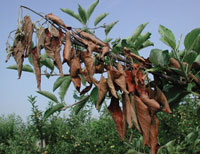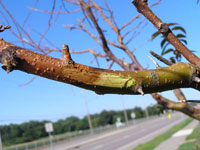Erwinia amylovora
Hosts
Crabapple, hawthorn, chokecherry and other members of the rose family (cotoneaster, mountain ash, raspberry)
Distribution and Disease Cycle

Photo credit: Ontario Ministry of Agriculture, Food and Rural Affairs
Fireblight is caused by a bacterium (Erwinia amylovora) that infects the tree through the blossoms, leaves or wounds in the stems or trunk. The bacteria overwinters in cankers on stem/trunk tissue, spreading the following spring/summer by rain, wind blown mist, pollinating or sucking/chewing/boring insects or unsterilized pruning tools. Warm temperatures (24-28º C) and high humidity favour infection and development of the disease. Because of the high incidence of wounding and generally moist conditions, fireblight can become very severe following hail storms.
Symptoms and Signs
Infected blossoms wilt and turn brown, while infected branch tips and leaves usually wilt and turn black, as if scorched by fire. On mature woody tissue, symptoms may include sunken, discoloured areas, cracks or bark splitting or peeling. Eventually, a watery ooze is usually emitted from infected tissues.

Photo credit: Michelle Grabowski, University of Minnesota Extension
Control
Prune current season cankers as they appear and any overwintering cankers during the dormant season. Make cuts at least 25 centimetres (cm) into healthy wood and disinfect pruning tools between each cut with full strength or 1:5 dilution of bleach, Lysol or Pine-Sol. If the infection is serious, frequent pruning and/or chemical applications may be necessary. When risk of disease spread is highest (during warm and moist weather in spring or early summer), spray with fixed copper, copper oxychloride or streptomycin sulphate as per the label instructions. Control of sucking insects that can spread the bacteria, particularly aphids and plant bugs may also be important. Any one control method may not be effective on its own; a combination of the above may be required to effectively manage this disease.